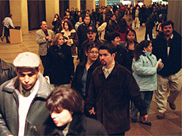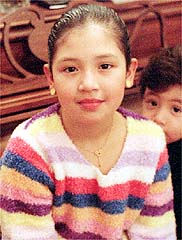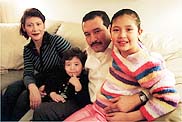|
 |
|
Esta página no está disponible en español. THE NEW YORK TIMESThe Latino Culture WarsBy Seth Kugel
February 24, 2002
Concert goers filing in for Radio Amor's (93.1 FM) El Concierto del Amor, featuring a line-up of artists from several Latin nations. ---------------------------- (PHOTOS: Rebecca Cooney / The New York Times) In two weeks, Gabriela Minueza, 9, a fourth grader at Public School 95 in Jamaica, Queens, will go to Albany with the school choir for the 25th anniversary conference of the New York State Association for Bilingual Education. She will take the solo in "Preciosa," a patriotic song by the Puerto Rican writer Rafael Hernández that was recently recorded by the Puerto Rican singer Marc Anthony. At one point, she will step forward and sing in Spanish: Whatever happens But whatever happens and wherever she goes, Gabriela will never be Puerto Rican. She is Guatemalan, born here to immigrant parents, and with traces of Mayan features to prove it. The classmates who will sing behind her, few of them Puerto Rican either, mistake her for Chinese, if anything. But in the sphere of New York elementary school music, as in language, culture and politics, being Latino in New York is tied to being Caribbean in general and Puerto Rican in particular. New York has the world's most diverse Spanish-speaking population, but it is still a city in which the Latino cultural icons are people like the Puerto Rican pop star Jennifer Lopez and the Boston Red Sox slugger (and pride of Washington Heights) Manny Ramirez. The city gave birth to the Nuyorican Poets Cafe, and is a place where the Puerto Rican street toughs of "West Side Story" and the romantic Latino aura of Spanish Harlem still resonate. A city in which the biggest Latino parades celebrate Puerto Rican and Dominican pride. A city of salsa and merengue. So, even as Mexicans, Ecuadoreans and others come to the city in increasing numbers, Puerto Ricans and Dominicans still make up the biggest pieces of the Latino pie. Of New York's 2.2 million Latinos, 830,000 are Puerto Rican and 579,000 Dominican, placing them first and second in a growing population, up from 1.7 million in 1990. That means Mexican, Central American and South American immigrants and their children not only have to adjust to the broader American culture, they try to avoid being engulfed by the dominant Latino culture. On any cultural battlefield, the first skirmish usually involves language. Just about every Spanish speaker in the city, regardless of age, feels a Caribbean breeze in their Spanish. To most Latin Americans, a bean is a frijol, but for Caribbeans, and thus in New York, it is an habichuela. And though many South Americans find the Caribbean word for bus, guagua, ridiculous, some say it occasionally escapes from their lips. Clara Bosworth, who lives in East Harlem, arrived in New York from Ecuador 38 years ago, in her late 20's. At first she suffered, grappling with a tongue both familiar yet strange. Eventually, she took to calling beans habichuelas, and has been known to say "guagua." She even breaks out with the Puerto Rican exclamation "Ay bendito!" and the occasional "OH-oh," the Dominican expression of surprise that starts with a high-pitched "OH" and flows into the lower-pitched "oh."
Her Mayan features aside, Gabriela Minueza of Queens will sing in praise of Puerto Rico next month. ---------------------------- Like about every other South American immigrant, she has a "bicho" story. In a Spanish-English dictionary, bicho means bug or insect. But in much of the Caribbean it is a vulgarity that refers to part of the male anatomy. Soon after her arrival in New York, Ms. Bosworth was at a party. A friend pointed to her wrist, which was red. "What happened to you, Blanca?" he asked. "Oh, I don't know when," she said, in Spanish. "But this bicho bit me." Another man overheard and chastised her: "Look, Señora, you need to learn how to speak!" "I turned red as a tomato," she said. As she fled the party, she realized that not only would she have to learn English, she would have to relearn Spanish. Puerto Rico: Still Dominant Puerto Rican culture has long been the city's dominant Latino culture. Even so, the Puerto Rican population has declined to 38 percent today from 80 percent of Latinos in 1960, according to the Lewis Mumford Center for Urban and Regional Research at SUNY-Albany, based on adjusted 2000 census figures. But because the Puerto Ricans were here first, learned English first, opened restaurants first, fought for their rights first and ran for office first, they still wield an influence that exceeds their shrinking demographic share. "Puerto Rico was the original common denominator," said Juan Flores, a professor in the department of black and Puerto Rican studies at Hunter College. But even as the proportion of Puerto Ricans shrank, many of their replacements came from the Dominican Republic. Inter- island rivalries make some people reluctant to admit it, but the two cultures have many similarities, from the food they eat to the music they make to the Spanish they speak to the baseball they play to the African blood in their veins. Add in a few Cubans, and the Hispanic Caribbean accounts for 67 percent of Latinos in New York; the rest are almost evenly divided between Mexico/Central America and South America, at about 16 percent each. The neighborhoods in which Latino groups live reinforce the Caribbean dominance. There are almost 200 census tracts in the city where Caribbean Hispanics make up more than 50 percent of the overall population, but there are no such tracts for either Mexicans and Central Americans combined or for South Americans, data from the Mumford Center show. That pressures the non-Caribbean groups, especially students. They are jockeying to maintain their own identity, while taking on Caribbean traits as they try to ease into American culture. "Young Latinos from different groups will tend to gravitate to Puerto Ricans," Mr. Flores said, "because Puerto Ricans have been around, they know the ropes, they know the way of walking and talking, rather than being fresh off the boat, being greenhorns." Younger Latinos also look to Dominican culture. Luis Delgado, 15, a freshman at Manhattan Academy for Science and Mathematics, lives in Washington Heights, which is so heavily Dominican that it elected the first Dominican, Guillermo Linares, to the City Council in 1991. Luis's Spanish accent is pure Dominican, and he is scolded by his Ecuadorean parents when he uses the informal Dominican "Qué?" for "What?" instead of the more formal "Mande?" "It's not like you do it on purpose," Luis said of his cultural makeover. "It just slips out." But essentially, Luis's friends say, he has become Dominican. Though he eats ceviche, an Ecuadorean fish salad, at home, he is happiest with the combination of rice, beans and meat known as "the Dominican flag." "He knows how to talk Dominican," said Laiheng Cabral, a Dominican classmate. "He knows how to dance Dominican." The Caribbean Gatekeepers Latinos from the Caribbean carry the day politically, too. There are 24 Hispanic elected officials representing New York on the local, state and federal level, according to Angelo Falcón, the senior policy executive for the Puerto Rican Legal Defense and Education Fund. Of them, 21 are Puerto Rican, 3 Dominican. So it's not surprising that the city's best-known Latino politicians, like Herman Badillo (the first Puerto Rican to hold a boroughwide office), Fernando Ferrer (the former Bronx borough president) and Mr. Linares (the former Council member and currently a deputy public advocate) are part of that lineage.
Gabriela Minueza, right, and her family are caught up in a peculiarly New York ethnic waltz. Even as they seek to preserve their Guatemalan identity, they feel pressure from the city's Puerto Rican and Dominican majority. ---------------------------- Citizenship by birth has given Puerto Ricans enduring political power, even as their numbers decline. "One of the things people need to understand is that while the demographics are very diverse, in terms of the Latino electorate it's not a straight translation," Mr. Falcón said. "Puerto Ricans may be 36 percent of the Latino population, but may be 60 to 70 percent of Latinos who vote." Dominicans' history of political activism, he added, and their "hypersegregation" in Upper Manhattan have helped them take some power, too. "The reality is, they are the same, and they are not the same," Mr. Ferrer said, referring to Latino groups. "It depends on the moment, the issue and the venue." Mr. Falcón said, "Puerto Ricans and Dominicans wind up being gatekeepers, so other groups have to deal with them." A Puerto Rican Boyfriend Many embrace the majority culture. Sandra Moya grew up in Woodside, Queens, and went to high school in her parents' native Ecuador. She became interested in Puerto Rico only after she entered La Guardia Community College in 1986. "A lot of Ecuadoreans resent that I'm more Puerto Rican than Ecuadorean," said Ms. Moya, who is now director of the Leonard Covello Senior Center in East Harlem, which is heavily Puerto Rican. When she was 19, Ms. Moya brought home a Puerto Rican boyfriend. She said her mother's reaction was something like, "Jesus, Lord have mercy!" Since then, Ms. Moya has tortured her with a string of Puerto Rican boyfriends, including three fiancés. One mother taught her to cook, so now she makes Puerto Rican food like arroz con gandules (rice with pigeon peas) much more often than Ecuadorean dishes. When her brother married a Cuban, her mother said she had been cursed by the Caribbean. A few years ago, Ms. Moya got the ultimate stamp of approval for her Puerto Rican status. She appeared in a picture of future leaders in the publication "Puerto Rican Women Achievers in N.Y.C." There are 144,000 Ecuadoreans in New York, making them the city's fourth-largest Latino group after the Mexicans (196,000). They find comfort in Ecuadorean organizations, grocery stores and dozens of restaurants. But fitting in is not easy for everyone. Michelle Morazán, 26, is one of the fewer than 10,000 Nicaraguans in the city. But since arriving at 3, her life has been braided with the Caribbean. Her mother married a Dominican and her grandmother a Puerto Rican. Ms. Morazán lived in the Dominican Republic briefly, but now lives in Upper Manhattan and has no Nicaraguan friends in New York; not on purpose, but because there are so few around. "In many ways I probably identify more with Dominicans than with Nicaraguans," she said. "We feel left out; we need to associate with something. I have to remind myself that I'm Nicaraguan. I hate to say that. It seems terrible." Waiting for Their Moment Still, among non-Caribbean Latinos, there is no set response to their minority role. Some resist the dominant Puerto Rican and Dominican cultures, some shrug in acceptance, some don't even realize they're being absorbed, and a few are waiting for their moment to take center stage. Marizol Minueza, the mother of Gabriela, the fourth-grade singer, isn't too worried about her daughter's singing a Puerto Rican anthem. Ms. Minueza, who came from Guatemala at 18, had misgivings at first, but felt better when the music teacher told her the performance would deepen her daughter's multicultural education. Gabriela's parents have also felt the Caribbean influence in their lives. "You no longer speak Guatemalan, you speak Puerto Rican," Ms. Minueza's mother scolds her. Gabriela's father, Gober, who came to New York at 6, said his father expunged Puerto Rican words from his Spanish. "When we brought different words home, he would be on top of us not to say those words," Mr. Minueza said. "Guatemalans have this thing that Puerto Ricans eat a lot of the letters, that was mostly his concern." What of Gabriela? Her solo is a Puerto Rican song, but P.S. 95, has festivals celebrating the diversity of its pupils, who are from Latin America and Asia. Last October, during a celebration of multiculturalism, she proudly showed off an embroidered rainbow of a dress from Guatemala.
|

 ----------------------------
---------------------------- ----------------------------
---------------------------- ----------------------------
----------------------------